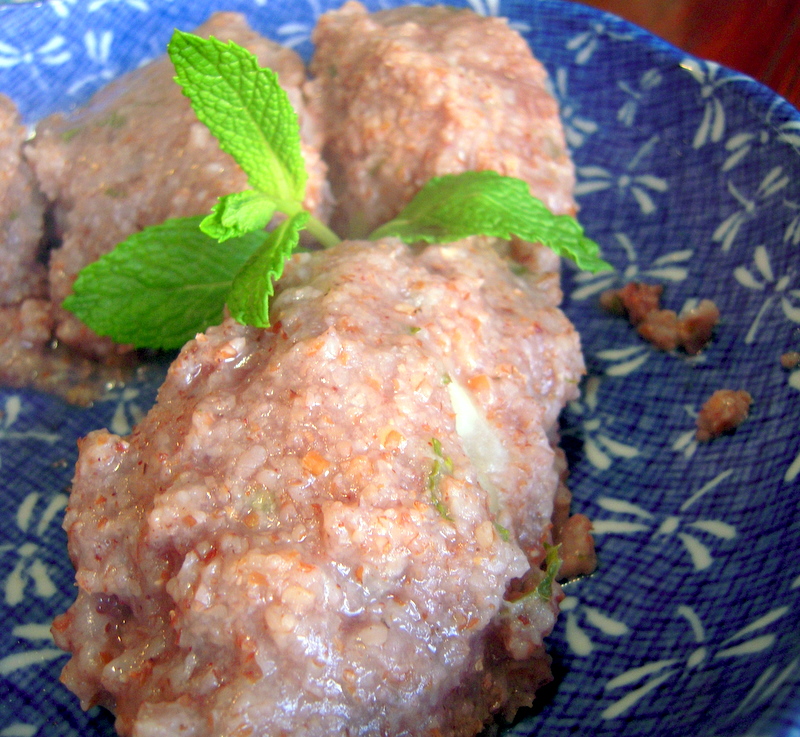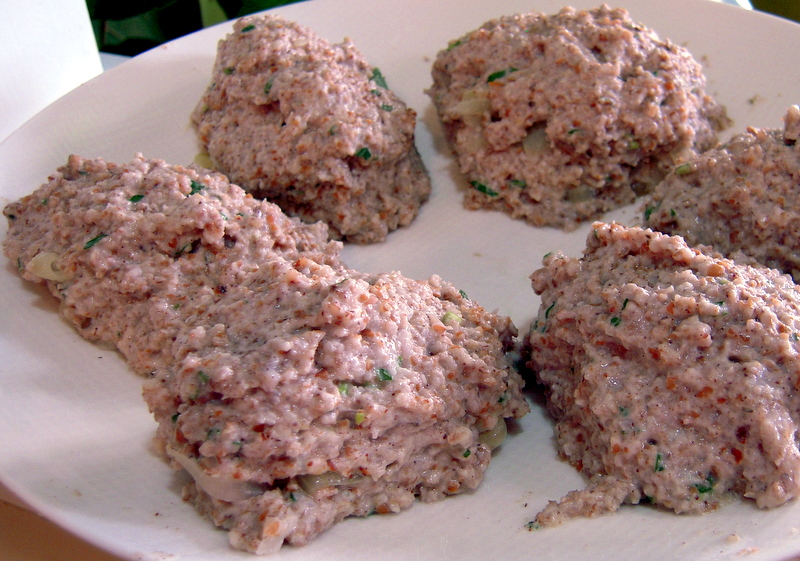This recipe comes from “The Rural Taste of Lebanon: a Food Heritage Trail.” I found it appealing because I’m unfamiliar with sumac, which I’ve also seen spelled “somak,” and I wanted to see what it might taste like.
The potato onion filling reminded me a lot of what you might stuff into Polish perogies. I had too much filling for the amount of dough, so we ate it the following night sautéed with vegetables.
I improvised a lot with the amounts of the ingredients as the original recipe measures everything in grams. I don’t have a kitchen scale. Also I used fresh rather than dried mint.
Making the dumplings proved to be a bit messier than I’d originally expected. I was very worried that they would fall apart while poaching, but they all turned out fine. I still have trouble describing the taste of sumac. The cookbook calls it “bitter and slightly acid.” That’s probably right. Yet it has a distinct flavor that that description doesn’t adequately pinpoint. A Lebanese friend of ours, Omar, was very familiar with this dish. He says that sumac has a citrusy flavor. Maybe…
This was good but not our favorite. They looked like large meat balls, though the recipe is completely vegan. Perhaps you might have suggestions for improvement?
Stuffed Sumac and Mint Bulgur Dumplings
1½ cups bulgur
¾ cup and 2 tsp sumac
1½ cups all purpose flour
1 small bunch fresh mint, finely chopped
5 small onions (or 2 medium), peeled and sliced
2 medium potatoes, peeled and cut into small dice
Kosher salt
Olive oil
Rinse bulgur then place in large bowl. Fill with boiling water, cover and let soak for 1 to 2 hours.
Prepare filling by boiling diced potato for about fifteen minutes. Drain and set aside. Sauté onion in some olive oil, about five minutes, until translucent. Add potatoes and salt to taste. Fold together. Set aside.
Drain soaked bulgur. Mix with 2 tsp sumac, mint, flour and salt to taste. Flour a work surface. Pour bulgur mixture onto surface and knead for about five minutes. You might add more water or more flour to control consistency. Mine seemed too wet but turned out perfectly well in the end.
Divide dough into about ten to twelve equal rounds. To stuff, insert the index finger of one hand into a round held in the other. Stuff with some of the potato and onion filling. Cover opening with bulgur dough.
To poach, boil a large pot of water with ¾ cup sumac for about ten minutes. Strain water and return to stove. Reduce to simmer. Gently place dumplings into water and allow to simmer for ten minutes. This may take more than one batch. Remove from sumac water to a serving dish. Garnish with fresh mint sprigs.



Comments on this entry are closed.
Interesting recipe. Middle eastern dumplings like these are usually fried rather than poached. I bet if I tried making them they’d fall apart all over the place (I’m so clumsy). I like the idea of the whole thing, because i don’t do deep frying, it scares me LOL.
Hope you have a wonderful weekend ahead.
*kisses* HH
Hi… we have something here that is derived from the lebanon kitchen and it also takes hamburguer meat, then fry or bake it and it is just delicious. Good recipe.
HH
I cannot believe that you’re clumsy if your prose is any reflection of your abilities. I’d say that you’re probably quite the opposite. I do agree with you that frying is scary, though mainly from the added poundage that comes with any food prepared that way. Have a great weekend yourself!
You’re talking about Brazilian kebbeh, right? I’ve had that when we still ate meat. Heguiberto recently made a vegetarian one that’s baked in a large dish that was pretty good. Have you ever had it that way?